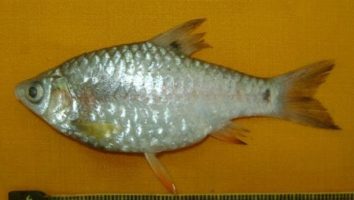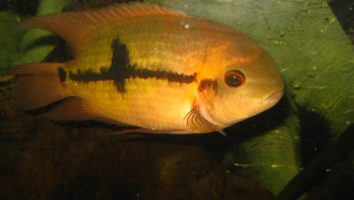Orangethroat darters are a beautiful and unique freshwater fish that are perfect for any aquarium.
This guide will teach you everything you need to know about Orangethroat darter care. You’ll learn about their diet, size, lifespan, and more!
Table of contents
Species overview
The orangethroat darter (Etheostoma spectabile) is a freshwater fish that is native to the southeastern United States.
They can be found in a wide variety of habitats, but prefer slow-moving streams with sand or gravel bottoms.
Orangethroat darters are carnivorous and eat a variety of small invertebrates.
These fish are relatively small, only reaching a maximum length of about 3 inches.
Orangethroat darters are popular among aquarium hobbyists because of their bright colors and patterns.
Appearance

The Orangethroat Darter is one of the most colorful freshwater fish that you’ll find in North America. They’re a small fish that only grows to be about 3-4 inches long.
The body of the Orangethroat Darter is long, thin, and slightly flattened from top to bottom. They have a forked tail that tapers off to a point. Both the dorsal and anal fins are short and reach about halfway back on the body.
What really makes this fish stand out is their coloration. The front half of their body is a beautiful golden color. The back half is a deep green. In-between these two colors is a bright orange stripe that runs down the length of their body.
This orange stripe is what gives this fish their name. The males are usually more colorful than the females with the orange being more vibrant.
The face of the Orangethroat Darter is quite unique. They have large eyes that sit on top of a protruding forehead. Underneath their chin, you’ll find a large orange sack. This is used to attract mates and can be quite prominent in males.
Lifespan
The typical lifespan of an orangethroat darter is 3 to 5 years. These fish are relatively long-lived compared to other fish in the wild.
However, their lifespan in captivity is often shorter due to the stress of being in an artificial environment. They’re also more susceptible to disease in captivity.
With good care, though, these fish can live up to 10 years in captivity.
Size
The orangethroat darter grows to an average length of 4 inches.
Tank
Tank Size
The recommended tank size for Orangethroat darters is 20 gallons. If you’re looking for a small freshwater fish that can fit in an average-sized tank, this is a good option.
Orangethroat darters are a peaceful species of fish and can be kept in a community tank with other small, peaceful fish. If you’re looking to keep more than one Orangethroat darter, you should add at least 10 gallons for each additional fish.
Water Parameters
The Orangethroat darter is a freshwater fish that is native to the United States. Its range extends from the Mississippi River basin east to the Appalachian Mountains.
This fish prefers clean, well-oxygenated water with a moderate amount of flow. It is often found in rivers and streams with gravel or sand substrates.
The ideal water parameters for Orangethroat darters are:
- Water temperature: 60 to 70 degrees Fahrenheit
- pH levels: 6.5 to 7.5
- Water hardness: 5 to 15 dGH
- Alkalinity Levels: 4-8 dKH
What To Put In Their Tank
The Orangethroat darter is a small freshwater fish that is found in the United States.
They prefer slow-moving waters with plenty of hiding places.
When setting up an aquarium for Orangethroat darters, it is important to provide them with plenty of hiding places. Driftwood, rocks, and caves are all great options.
Plants can also be used, but be aware that these fish may eat them.
The substrate should be soft and sandy to help prevent injuries.
Common Diseases
The Orangethroat darter is a hardy fish that doesn’t often fall ill. However, like all fish, they can still get sick if the conditions in their tank are not ideal.
The most common disease that these fish experience is ich. This is a very contagious disease that is caused by a parasite. It can be fatal if left untreated, so it’s important to be on the lookout for the symptoms.
These include white spots on the body, gills, and fins. The fish may also scratch themselves on objects in the tank and have a decreased appetite.
If you notice any of these symptoms, it’s important to act fast. Begin treatment immediately and consult your vet if necessary.
Another disease that these fish can experience is hole-in-the-head disease. This is caused by poor water quality and the presence of activated carbon in the tank.
It will present itself as one or two pits/holes in the skin of your fish’s head. While it’s almost always curable, it will usually leave some scarring on your fish.
To prevent these diseases, it’s important to maintain the quality of the water in your tank. A tank with clean and stable water conditions is always the best way to keep your fish healthy and disease-free.
Behavior & Temperament
The orangethroat darter is a peaceful fish that is also known to be shy. It is not an aggressive fish and will not bother other tank mates. It is a bottom-dwelling fish that spends most of its time near the substrate.
The orangethroat darter is a nocturnal fish, so it is most active at night. During the day, it will often hide among the plants and rocks in the aquarium.
Tank Mates
The Orangethroat darter is a peaceful fish that can get along with most tank mates.
These fish are relatively small, so they’re not a threat to other fish in the tank. In fact, they’re more likely to be on the receiving end of aggression.
With that said, it’s important to choose tank mates that are compatible in terms of size and temperament.
Here are some good Orangethroat darter tank mates:
- Guppies
- Mollies
- Platies
- Swordtails
- Neon Tetras
- Cherry Barbs
- White Cloud Mountain Minnows
Breeding
The Orangethroat Darter is a beautiful little fish that is perfect for the home aquarium. They are relatively easy to care for and make a great addition to any community tank.
Orangethroat Darters are also one of the easier fish to breed in captivity. If you follow a few simple guidelines, you should have no problem getting them to spawn.
First, you need to set up a breeding tank. The tank should be at least 20 gallons in size and should have a sandy bottom. Live plants are also a good idea.
Next, you need to adjust the water parameters. The pH should be between 6.5 and 7.0 and the temperature should be between 72 and 78 degrees Fahrenheit.
Once the tank is set up, you need to add a pair of Orangethroat Darters. It’s best to add one male and one female. The male will have a more colorful throat than the female.
The next step is to start feeding the fish live foods. This will help to bring them into breeding condition.
Once the fish are ready to breed, the female will lay her eggs on the plants. The male will then fertilize the eggs.
After the eggs are fertilized, the parents should be removed from the tank. The eggs will hatch in about a week.
Once the fry hatch, they will feed on small live foods. You can also give them finely crushed flake food.
As the fry grow, you can start to add them to your community tank.
Conclusion
The Orangethroat Darter is a great choice for anyone looking for a unique and beautiful fish to add to their aquarium. They’re not the easiest fish to care for, but with a little bit of knowledge and dedication, they can be a great addition to your tank.
If you’re up for the challenge, we say go for it! These fish are definitely worth the effort.












